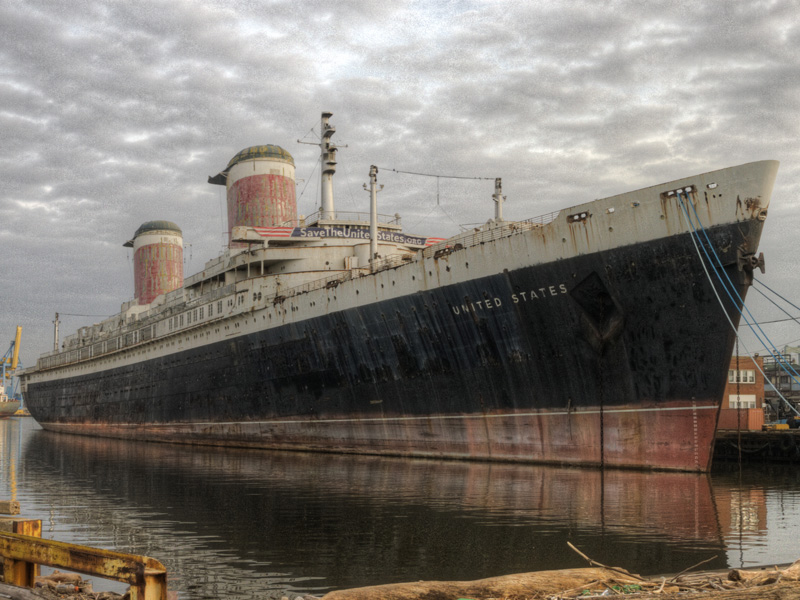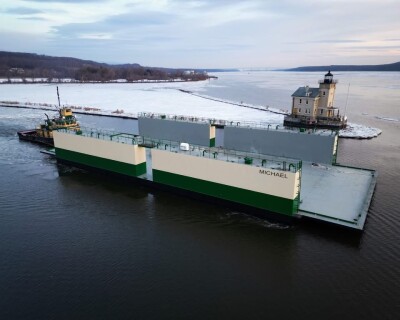A six-month, $1 million engineering study of the SS United States concluded it is unfeasible to convert the 1950s ocean liner for modern passenger service, leading Crystal Cruises to back out of its option to refurbish the ship.
“Unfortunately, the hurdles that would face us when trying to bring a 65-year-old vessel up to modern safety, design and international regulatory compliance have proven just too great to clear in both a technically and commercially responsible manner,” said Edie Rodriguez, president and CEO of the Century City, Calif., based high-end cruise company.
The historic 990’x101’ liner is not in immediate danger, as it was in fall 2015 when the non-profit SS United States Conservancy mounted an urgent appeal for funding to maintain the ship in Philadelphia. Crystal Cruises is donating $350,000 cash to the conservancy, and all data and findings from the engineering surveys and analyses.
That work showed the ship’s hull and structure are sound, and could help the conservancy return to its original goal of finding backers to refurbish the ship into a mixed-use waterfront museum and commercial destination in its old homeport of New York or another coastal city.
“These assessments included: underwater inspections of the hull by divers, examinations of her fuel and salt water ballasting tanks, three-dimensional scans of the entire vessel, preparation of a vessel tow plan, and a series of intensive engineering and technical studies,” said Susan Gibbs, executive director of the conservancy. “Crystal has generously provided many of these materials to the Conservancy, and these will be invaluable to us as we advance redevelopment alternatives.”
Early this year the surprise announcement that Crystal Cruises had negotiated a possible restoration plan with the nonprofit SS United Conservancy set off excitement – and not a little skepticism – in both the cruise industry and maritime history communities.
But an engineering team, led by retired Coast Guard Rear Adm. Tim Sullivan, emerged from their months of work aboard the liner, tied up in Philadelphia for the last 20 years, with a frank assessment.
“Regrettably, the technical feasibility study concluded that while the ship is remarkably intact and structurally sound, modifying the ship for today’s standards for oceangoing service (SOLAS) would require significant changes to the hull that would pose stability challenges,” according to a statement from Crystal Cruises. “Additionally, the installation of a modern, state-of-the-art diesel electric propulsion plant would have necessitated altering of the existing shaft lines and rebuilding about 25 percent of the hull to reconfigure the ship to a twin shaft-twin rudder arrangement.
“While it was known that the vessel would need to have been essentially rebuilt from the inside out, these specific challenges, among others, collectively posed significant risk to the success of the project.”
Early rough estimates for returning the ship to service were around $700 million, including modernization of the passenger decks and cabins and extension of new stateroom balconies that are standard on modern cruise liners. That would have been less than the cost of a newbuild, if a diesel-electric conversion had been practical.
The ship’s original four propellers were each driven by a Westinghouse turbine, fed from eight Babcock & Wilcox boilers. They gave the SS United States its top speed of 38.32 knots at 241,785 hp during sea trial, and record Atlantic crossing cruise speeds around 35 knots.
A rendering produced by Crystal Cruises imagined the refurbished, sleeker SS United States steaming past New York still with its iconic red, white and black stacks with winglets. Gibbs said the conservancy again hopes to bring the ship back to the city.
“Crystal’s comprehensive assessments of the SS United States determined that the vessel remains in remarkably strong structural condition, as the Conservancy has long contended,” Gibbs said. “That means America’s Flagship still has enormous potential as a stationary mixed-use development and museum in New York or another urban waterfront setting. We will immediately resume our aggressive outreach to qualified developers and investors to secure the ship’s future.”





